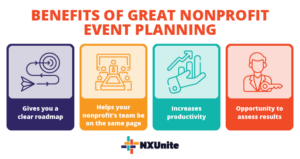Nonprofit Event Planning — Nonprofit Catalog
Nonprofit events are a valuable way to reach supporters and keep them involved in your organization, but how do you get started? That’s where nonprofit event planning comes in. As CharityBid’s all-in-one guide to nonprofit event planning points out, being organized in your efforts from the beginning sets your event up for success. Nonprofit event planning helps you keep track of your goals and unites your entire team to work towards greater supporter engagement, a high return on investment, and an overall memorable event that will retain supporters in the long run.
What is nonprofit event planning?
Nonprofit event planning is the best way to maximize your event’s success. This process involves laying out clear goals, the specific ways you’ll achieve them, and how you’ll measure progress.
If you rush through event planning, you won’t have a clear roadmap for success and likely won’t receive a return on your investment. A haphazardly-planned event may also leave supporters with a bad impression of your organization, causing you to lose out on key support.
Instead, set yourself up for fundraising success by engaging in nonprofit event planning.

A well-planned nonprofit event has multiple benefits.
- Gives you a clear roadmap. Effective event planning minimizes stress for everyone. You and your team will operate better if everyone has a solid understanding of the objectives to work towards.
- Helps your nonprofit’s team be on the same page. Clear communication of expectations and roles will help your team feel confident in how to move forward.
- Increases productivity. It takes less time to form a plan at the beginning of the process than to confront challenges and confusion in team member responsibilities down the road.
- Opportunity to assess results. When you have a plan that you’re following and adjusting as needed based on donor engagement and other relevant factors, it’s easier to take stock of what is and isn’t working. If you don’t collect data and analyze your progress, your team may be prone to unnecessarily repeat the same mistakes next time.
While event planning takes time and effort, it will be well-worth it to reach your fundraising and engagement goals.
Nonprofit event planning steps
Since nonprofit event planning is essential to running a successful event, be sure to take ample time to form your plan and discuss it with your team. Let’s explore some steps to help you get started.
1. Determine your event objectives.
A good place to start is deciding what your goals are for the event. These will be tailored to your organization’s mission and current needs. For example, consider the following objectives:
- Fundraising goal
- Number of donors in attendance
- Number of new donors you hope to acquire
- Average gift size
The more specific your goals are, the better. You’ll also want to provide a timeline for your event and when you hope to reach certain milestones by. Clearly outlining your goals and their priority levels will allow you to shape your event to effectively meet them.
2. Create an event planning committee.
Dividing planning responsibilities among team members with clearly defined roles is key to a successful event. Assemble your event planning committee in advance of your event by reaching out to devoted donors, volunteers, board members, and staff. To ensure that you have the right team, provide an accurate description of the responsibilities and time commitment needed, so that everyone will work productively towards achieving your goals.
3. Decide on your event budget and timeline.
Create a budget based on your event’s goals and purpose. If you’re working with a limited budget, you can look for other funding sources like corporate sponsors, or choose a cost-friendly event idea that allows you to maximize your ROI.
Give yourself substantial time to plan your event because you don’t want to be rushed in the process. Your proposed timeline should be reasonable based on the scale of your event. For instance, if you’re planning an in-person gala for hundreds of supporters, you’ll need several months to book a venue and catering, and to plan other essential details. Planning your nonprofit event well in advance will also allow you time to boost excitement among attendees, and to fundraise before the event itself.
4. Identify your target audience for the event.
Know who you are trying to reach with your nonprofit event. What kinds of events or activities would that audience be interested in? Create an event attendee persona, and keep this person in mind as you plan an event tailored to their needs and interests.
5. Determine how you’ll raise money during your event.
Whether it’s selling tickets before the event or hosting auction activities during the event itself, you’ll need a revenue stream to reach your fundraising goals. Customize your fundraising approach to your target audience to increase the likelihood that they’ll give. For example, if your audience often donates via text-to-give in large numbers, create a text-to-give campaign leading up to your event and on the day-of to boost donations.
6. Make all nonprofit event arrangements.
For an in-person event, book your venue ahead of time, consider your catering options, and settle on entertainment that is within your budget and would appeal to your audience. Planning virtual events will look slightly different and require you to think about other event components. For example, instead of a venue and catering, you’ll need technology solutions that will allow your organization to livestream, offer options for attendees to interact with each other, and allow you to incorporate other immersive elements to keep supporters engaged.
7. Market your nonprofit event.
Start promoting your event well in advance to increase the buzz surrounding it, and to encourage supporters to sign up as soon as possible. To expand your reach, take a multichannel marketing approach with platforms like email, social media, and your nonprofit’s website. In your marketing materials, provide the basic event details, the purpose behind your event, and a registration link to facilitate an easy sign-up process.
8. Recruit volunteers to help run your event.
You’ll need volunteers to lend a hand towards organizing, running, and cleaning up after your event is over. Designate a specific member of your event planning committee to coordinate your volunteer recruitment and onboarding efforts. Be sure volunteer roles are clearly defined so that they know what to expect, then remember to send volunteers a thank you letter afterwards expressing your gratitude!
9. Plan your follow-up activities.
Connect with supporters while your organization is still on their minds. In addition to sending thank you notes to those in attendance, offer ways that supporters can learn more about your mission and stay involved in your nonprofit.
You’ll also want to reflect on your results and whether you hit your fundraising objectives. This will help you understand how you can optimize your events for the future.
By following these steps, you’ll be well on your way to planning and hosting a successful nonprofit event!
Additional Resources
- Nonprofit Catalog – Read up on more nonprofit essentials by exploring our Nonprofit Catalog.
- Nonprofit Marketing: A Guide for Amplifying Your Mission – Learn more about nonprofit marketing strategies and how your organization can improve your current efforts.
- 215+ Amazing Fundraising Ideas for Your Organization – Check out this list of 215+ fundraising ideas to breathe life into your organization’s fundraising efforts.


